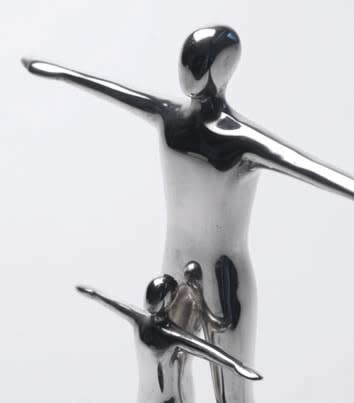Glenys Barton
Birth, 2002
Sterling Silver
15.5 x 15.5 x 14.5 cm
6 1/8 x 6 1/8 x 5 3/4 in
6 1/8 x 6 1/8 x 5 3/4 in
Edition 1 of 6
Copyright of Artist/ Pangolin London
Currency:
Further images
“I love the colour of silver. I never wear gold, and highly polishing it to reflect the figures gave added excitement and depth to the piece... I realise now, in...
“I love the colour of silver. I never wear gold, and highly polishing it to reflect the figures gave added excitement and depth to the piece... I realise now, in 2008, that this piece also expresses what I had felt as a mother when my son left home around that time. Perhaps its title “Birth” should be changed to “Letting Go”. I often find, in hindsight, that the subjects that crop up in the studio unconsciously turn out to mirror the events and emotions of life.” Glenys Barton Glenys Barton is a sculptor working mainly in ceramic and bronze. She was born in Stoke-on-Trent in 1944, trained at Royal College of art 1968-71 and her work has been collected and exhibited widely, in Britain and abroad. She lives and works in Essex, UK. Barton was one of the few British sculptors working mainly in ceramic in the 70s. Her precise geometrical forms made her work highly distinctive. She gained quick success after graduating and was the British prize winner at the International Ceramics Exhibition, 1972. She was invited to serve on the newly formed Crafts Advisory Committee, as its youngest member. At this early stage in her career, Angela Flowers offered Barton her first solo exhibition in London. This resulted in a career-long partnership with (what is now) Flowers Gallery and Barton has presented regular solo exhibitions with them since 1974.Since the 1980s her work has centered on the human form, the head in particular. She is best known for her ceramic portrait sculptures and became widely recognised in 1993 when her ‘Jean Muir’ was shown in the 'Portrait Now' exhibition at the National Portrait Gallery, London. The Jean Muir sculpture was used as the lead publicity image for the exhibition, featuring on all exhibition publications and posters throughout the London Underground. The NPG subsequently added a Jean Muir figure to their collection and commissioned a sculpture of Glenda Jackson. Barton's Helena Kennedy and a head of Jean Muir are in the collection of the Scottish National Portrait Gallery. A monograph on her work, 'Glenys Barton', was published by Momentum in 1997, with a foreword by Charles Saumarez Smith, introduction by Robert Heller and essays by Edward Lucie-Smith and Robin Gibson. Glenys Barton describes her work: ‘My subject is always humanity: sometimes a specific human, sometimes human relationships, sometimes human society. The forms may be heads, parts of figures, whole figures or figures within figures. Heads and hands particularly fascinate me. As I work I feel that I am directly linked with those who have tried to fashion the human form from the earliest times. My greatest achievement would be to create a timeless image.’ Glenys Barton 2011
Provenance
From the artist
Exhibitions
Sterling Stuff II, 2008/2009, PL
Literature
Sterling Stuff II, 2008/2009, PL
Publications
Sterling Stuff II, 2008/2009, PL







